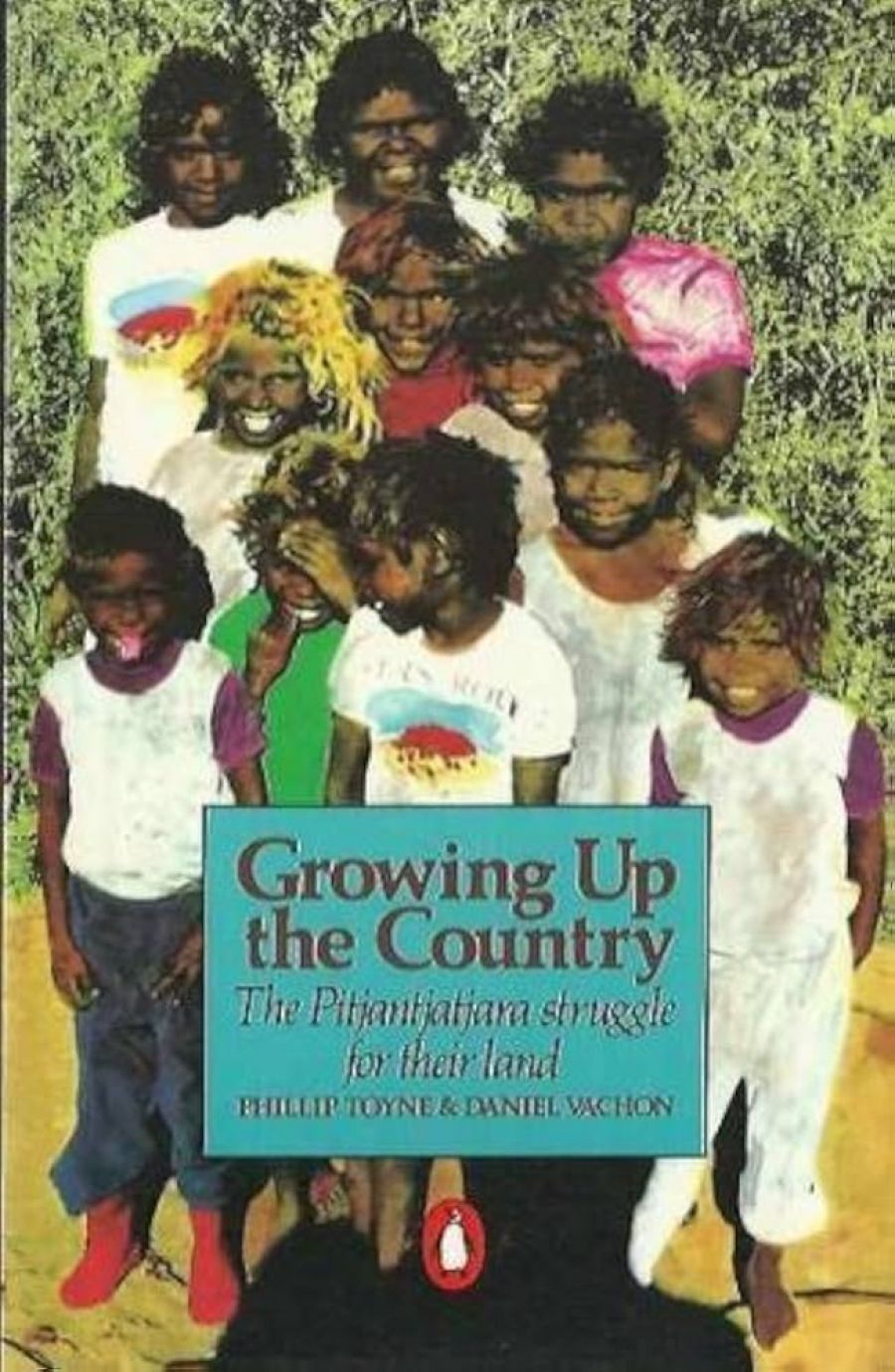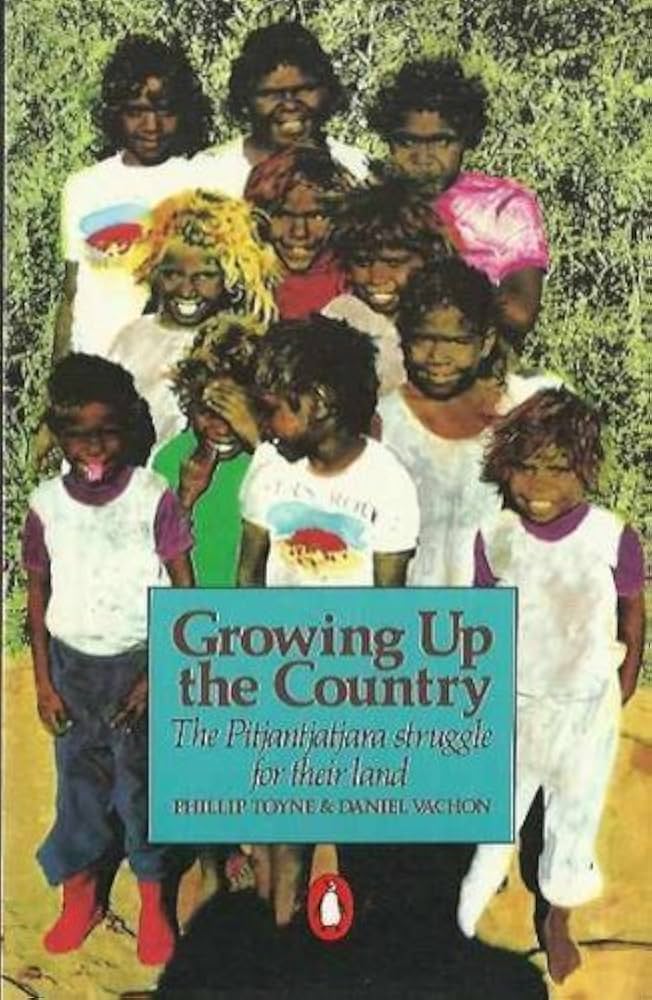
- Free Article: No
- Contents Category: Australian History
- Review Article: Yes
- Article Title: Understanding land rights
- Online Only: No
- Custom Highlight Text:
This book covers an important historical era in Aboriginal–European/Australian relationships. It describes in admirable detail the negotiations between the Pitjantjatjara people of north-west South Australia and their advisors on one side, and the South Australian government and bureaucratic departments on the other during the long hard battle to obtain title deeds to their land.
- Book 1 Title: Growing Up the Country
- Book 1 Biblio: Penguin, $6.95 pb, 200pp
- Book 1 Cover Small (400 x 600):

- Book 1 Cover (800 x 1200):

The book covers not only discussion and disagreement with government, miners and pastoralists but also with neighbouring Aboriginal communities, whose advisors saw solutions to problems in a quite different light. The culmination of the negotiations in the presentation of title deeds must have given the authors a great deal of satisfaction, but only time will tell if ‘inalienable title’ has real relevance when examined by future government, or even by the present government as situations change.
The early chapters explain with sensitivity the Aboriginal people’s association with their land, but unfortunately do not explain the most important points of all – the religious – the spiritual totemic association with sacred sites, and that one of the reasons for land ownership is to afford protection for the sacred sites. Such explanation is necessary to enable the reader to learn to refute suggestions that Aborigines ‘invent’ sacred sites for convenience, a constant slander used by biased people.
The paragraph on page five describing how a rock may be their ‘grandfather’ has little impact as it is not explained that the person and the rock, which is sacred, contains the same spirituality that they call kurunpa. Perhaps this is what Yami Lester refers to in his prologue.
It is very pleasing to note the emphasis placed on what authors realise – that the location of sacred sites should not be recorded on any document – that sacred site locations belong solely to the Aboriginal people, to be revealed at the right time in the right ceremonies, to their postulants. The policy insisted on by the authors that areas be declared either free for exploration or out of bounds by the Aboriginal owners, without them having to provide reasons why, is wise and entirely necessary for the preservation of traditional culture. The acceptance of this policy by various mining exploration companies is an important milestone in the negotiations.
The book is not one that will have general and popular appeal, but is more a reference book for students of Aboriginal Studies and Social Science. It is here that some deficiencies become apparent, firstly in that it has no index. The book does not follow a time sequence through its chapters, so making it necessary to refer back many times to statements previously made. The second major deficiency is the absence of source references. Many statements are made, to be construed by the reader as proven facts but are really conjecture, by no means acceptable to all other researchers. Without source references, it is not possible to test their statements against other opinions.
Again, their research has not been done with sufficient care to give the reader confidence in its accuracy. For example:
Pages thirty-three to thirty-four. Reference to damage done by International
Nickel at Wingellina is not correct. No mining was carried out by them. Only test bores of about 15 cm diameter were drilled in places approved by Ngaatjatjara men they employed for that purpose. Had mining commenced there is no doubt that there would have been extensive damage, but it did not eventuate. Dingo sacred sites nearby were destroyed by chrysoprase miner Gianni, and subsequently by a variety of other operators, as the mining lease changed hands several times.
On page 127, in discussing petrol sniffing and drunkenness, the reader would assume from the text that Aboriginal people in the north-west have largely escaped the problems encountered at Yalata, whereas, in fact, petrol sniffing is a growing problem in most of Aboriginal Australia. The fist Pitjantjatjara youth to die of petrol sniffing was at Amata in 1976, and the problem is becoming progressively worse. Figures provided by Nganampa Health Council in July 1984 reveal that, at Amata, fifty-four percent of young people from ages ten to twenty-four are petrol sniffers, half of whom are listed as ‘chronic’.
The point is, of course, that such problems will never be solved unless recognised, discussed and all expertise brought to bear to solve them. There is no point in suggesting that the problem will lessen now that people have land rights.
The relating of a myth in Chapter One would have been more relevant if one had been chosen from the many that illustrate the religion involved, and the relevance to traditional law. The one quoted is a surface story, the kind that is told to prepare children for acceptance of the serious Spirits Ancestors’ teachings. Then, the book’s title is puzzling. ‘Growing Up the Country’ (a phrase that alludes to child rearing) seems inappropriate here, where the people’s philosophy is that their spirituality stems from the country, not the reverse. In Pitjantjatjara law, the country was ‘grown up’ by the Spirit Ancestors in the tjukurpa – the Dreaming – the people were, of course, ‘grown up’ by the country and are entirely dependent on the country, both physically and spiritually.
In spite of these criticisms, I recommend this book to all serious students of Aboriginal–European relations. It should remain in print for students (hopefully a revised edition) and be followed by another volume recording further progress in due course, as the Pitjantjatjara people still have a long struggle ahead of them.


Comments powered by CComment